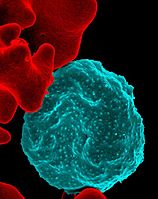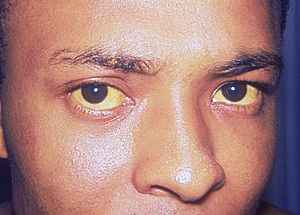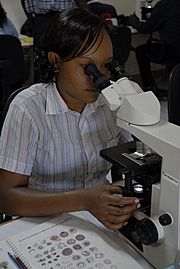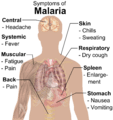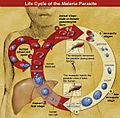Malaria facts for kids
Malaria is a serious sickness caused by tiny living things called parasites. These parasites get into people when an infected mosquito bites them. Once inside, the parasites enter the blood and cause a dangerous infection. Malaria makes many people very sick and sadly, it kills many people every year.
The parasite that causes malaria is called Plasmodium. It is a type of protozoa, which are tiny living things made of just one cell. Protozoa are different from bacteria; they are usually larger and more complex.
Most people get malaria from the bite of certain mosquitoes, like the Anopheles or Culex mosquitoes. These mosquitoes are known as vectors because they carry the disease. When an infected mosquito bites someone, it injects its special saliva into the person. This saliva contains the Plasmodium parasites. The mosquito's saliva also has a chemical that stops blood from clotting. This is how the Plasmodium parasites get into a person's body, causing malaria.
Only female mosquitoes can spread malaria. This is because only female mosquitoes drink blood. Male mosquitoes eat nectar from flowers. Female mosquitoes need the protein from blood to help their eggs grow.
Sometimes, people can get malaria in other ways too. A baby can get malaria from its mother before it is born. This is called maternal-foetal transmission. People can also get malaria from a blood transfusion, which is when someone receives blood from another person. Another way to catch malaria is by sharing a needle that was used by someone who has the disease.
Contents
The Malaria Parasite Life Cycle
The red blood cells are infected next, at this stage symptoms of malaria appear.
When an uninfected mosquito bites an infected human they become infected and continue the cycle.
The small bumps on the infected cell show how the parasite remodels its host cell. Uninfected cells (red) have smoother surfaces. Credit: NIAID/RML
There are several kinds of Plasmodium parasites that cause malaria in humans:
- Serious types:
- Milder types:
- Plasmodium malariae
- Plasmodium ovale
- Plasmodium vivax
- Types that usually infect other primates:
- Plasmodium knowlesi
P. vivax and P. falciparum cause most malaria cases in people. P. falciparum malaria is the most dangerous kind and causes the most deaths.
When Plasmodium parasites enter the blood, they are called sporozoites. These sporozoites travel to the liver, where they multiply and change into a different form called merozoites. The merozoites then leave the liver and enter the red blood cells, where they multiply even more.
The merozoites keep breaking out of the red blood cells again and again. Each time they do this, the person gets very sick and shows symptoms of malaria. This often happens every few days and is called a paroxysm.
Some types of malaria, like P. vivax and P. ovale, can stay hidden in the liver for a long time. A person might feel well, but the Plasmodium is still in their liver. This is called a dormant phase. Weeks or even months later, the parasites can leave the liver and enter the blood, making the person sick again.
P. falciparum is the most dangerous type of malaria. It makes people sicker than other types because more parasites grow in the blood. Also, with falciparum malaria, the infected red blood cells become sticky. These sticky cells can block tiny blood vessels. If blood vessels are blocked, it can harm the organs that rely on that blood supply.
Who Gets Malaria?
Pregnant women and young children are most affected by malaria. When they get malaria, they often become much sicker.
About 40% of people in the world live in places where malaria is common. These places include:
- Africa
- Asia (especially India, the Middle East, and Southeast Asia)
- Central and South America
- Hispaniola (an island in the Caribbean)
- Eastern Europe
- The South Pacific (the part of the Pacific Ocean south of the equator)
Every year, between 300 million and 700 million people get malaria. It kills about 1 million to 2 million people each year. A very large number, 90%, of these deaths happen in Africa. Most of the people who die from malaria are children. Even if children do not die, many can suffer brain damage.
Many of these deaths could be prevented with medicine or by controlling mosquitoes. However, many places where malaria is found are poor countries. These countries often do not have enough money to stop the mosquitoes or to give people medicine. Money is not the only problem. A country also needs a well-organized medical system to help people. Many countries in central Africa have faced warfare and conflict, which makes it hard to provide health services.
Also, it is harder to kill the parasites now than it was 50 years ago. This is because mosquitoes have become resistant to many insecticides. The Plasmodium parasite has also become very resistant to quinine and most other common drugs. This is a normal evolutionary process. The chemicals kill the weaker organisms, and the stronger, resistant ones survive and multiply.
Signs and Symptoms of Malaria
Symptoms are changes in someone's body that show they have a disease. Most people get malaria symptoms 10 to 30 days after the Plasmodium parasites enter their blood. But some people might get symptoms in just a week, while others might not show symptoms for a whole year.
The most common symptom of malaria is a fever, which means a high body temperature. The fever from malaria usually starts very suddenly. People with malaria often feel like they have the influenza (flu).
Common symptoms of malaria include:
- Arthralgia: Pain in joints.
- Headache: Pain in the head.
- Feeling very tired or sleepy.
- Cough.
- Chills: Feeling very cold and shivering.
- Delirium: When people are very confused because of the sickness. They might not be able to talk clearly.
- Coma: When people are not conscious. They look like they are asleep and cannot be woken up.
Signs that doctors might see in someone with malaria include:
- Anemia: Low levels of red blood cells in the blood.
- Diarrhea.
- Jaundice: Yellow skin and eyes.
- Sweating.
- Vomiting.
- Fast heart rate.
- Low blood pressure.
- Enlarged organs: When organs become bigger than normal.
- Hepatomegaly: An enlarged liver.
- Splenomegaly: An enlarged spleen.
- Sometimes both (hepatosplenomegaly). When these organs get bigger, it can cause pain in the upper right part of the stomach.
Complications from Malaria
Complications are other health problems that can happen because of a disease.
Pregnant women and young children are more likely to have complications. People who get malaria for the first time also have more complications. Falciparum malaria causes the most complications.
| Complications of malaria | ||
|---|---|---|
|
Complications of malaria are:
|
||
How Doctors Diagnose Malaria
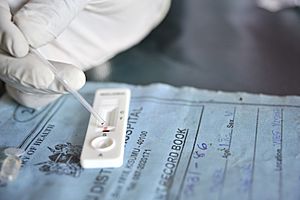
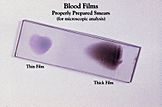 |
||
 |
||
| A technician looks for the malaria parasite in blood films (blood smears). | Microscopic view of malaria parasites in a blood smear. Arrows point to infected red blood cells. |
Clinical Diagnosis
A clinical diagnosis is when a doctor decides what sickness someone has based on their signs and symptoms. This is done without special medical tests. For malaria, a fever is one of the main signs that might lead to a clinical diagnosis.
Any clinical diagnosis of malaria should be checked and confirmed by a trained medical professional using lab tests as soon as possible.
Malaria Rapid Diagnostic Test
A Malaria rapid diagnostic test (RDT) is a blood test that can confirm if someone has malaria in about 20 minutes. RDTs are not perfect and have some downsides. If an RDT shows a negative result, it should not be fully trusted. Doctors should still follow up with a malaria microscopy test to be sure.
Malaria Microscopy
To see if patients have malaria, doctors might do a blood test called a Giemsa blood smear. A small amount of blood is put on a thin piece of glass called a slide. A special stain called Giemsa is added to the slide. This stain helps doctors see the malaria parasites more clearly. Then, they look at the slide under a microscope. The Plasmodium parasites can be seen inside the red blood cells.
Treating Malaria
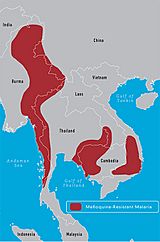
People with different kinds of malaria need different medicines. A medicine that works for one type of malaria might not work for another. So, it is very important to know which species of Plasmodium parasite the person has.
If the exact type of parasite is not known, the person should be treated as if they have falciparum malaria. This is because falciparum malaria is the most serious kind.
It is also important to know where the person caught malaria. This is because Plasmodium parasites in some places are resistant to certain medicines. So, the medicines used to treat malaria in Africa might be different from those used in South America.
Treating Malaria (Not Falciparum Type)
Everywhere except New Guinea, the treatment for non-falciparum malaria is the same. In New Guinea, most P. vivax is resistant to a medicine called chloroquine. There, it can be treated with quinine, but this medicine can make people feel sick. In most other places, non-falciparum malaria is treated with chloroquine.
Chloroquine kills the Plasmodium parasites in the blood. However, it does not kill the parasites that hide in the liver. P. vivax and P. ovale can stay in the liver for a long time in a dormant phase. So, another medicine must be given along with chloroquine for P. vivax and P. ovale. This extra medicine is called primaquine, and it kills the parasites in the liver. In Southeast Asia, some P. vivax is resistant to primaquine. But in most other places, primaquine works very well.
Some people can get very sick from primaquine. Because of this, people need to be tested for something called G6PD-deficiency before they can take primaquine.
Treating Falciparum Malaria
Falciparum is the most serious kind of malaria. People with falciparum malaria should be treated in a hospital if they are:
- Very sick.
- Children.
- Pregnant.
- Having malaria for the first time.
- Not able to take medicines by mouth.
Even people who are treated with medicines at home should stay with the doctor for about 8 hours. This is to make sure they do not get sicker and can take their medicines properly. Malaria usually does not become life-threatening until a couple of weeks after the mosquito bite if it is not treated.
Falciparum malaria also has more resistance to medicines. This makes it much harder to treat. Falciparum malaria is always treated with two or more medicines. Doctors choose the medicines based on where in the world the person caught malaria. Different places have P. falciparum that are resistant to different medicines.
The most important resistance is to chloroquine. In some parts of the world, P. falciparum can be killed by chloroquine. In other places, it is chloroquine-resistant, meaning chloroquine does not work. In these places, quinine can be used. Quinine is usually taken by mouth.
How to Prevent Malaria
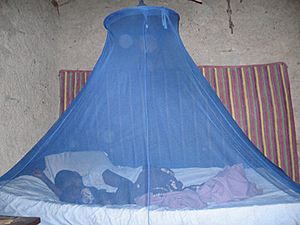
There are three main ways to prevent malaria:
- Control mosquitoes.
- Stop mosquitoes from biting people.
- Take medicine to prevent getting sick after a bite, especially in areas where malaria is common.
Controlling Mosquitoes
Vector control is one way to stop malaria. A vector is an organism that carries an infectious disease to another organism. For malaria, the vector is the Anopheles mosquito.
The most common method of vector control is using pesticides. These are chemicals that kill mosquitoes. The first pesticide used for vector control was DDT. DDT worked very well to kill mosquitoes. It did not seem to make people very sick at the time it was used, and it was not expensive. Other chemicals for vector control had not been invented yet.
In many places, mosquitoes became resistant to DDT. This meant that DDT no longer worked in those areas. Scientists also worried that DDT was making people and animals sick. It killed a lot of wildlife too. DDT also stays in the environment for a long time. For these reasons, people mostly use other chemicals for vector control now. Organophosphate or carbonate pesticides, like malathion or bendiocarb, are used instead.
Vector control is not the only way to stop malaria. And DDT is not the only chemical that can be used. The best way to stop malaria is to use a combination of methods. In some places, DDT can still be a useful part of a program to stop malaria. This is why DDT is still allowed for controlling malaria in certain situations.
Stopping Mosquito Bites
The mosquito that carries malaria is most active at dawn (when the sun comes up) and dusk (when the sun goes down). It is important to be extra careful during these times. Wear long trousers and shirts with long sleeves. Use mosquito repellent, which is a chemical that mosquitoes do not like, so they stay away. Mosquitoes can bite through thin clothes, so repellent should be used on both skin and clothes.
Pesticides can also be sprayed in rooms to kill mosquitoes. When sleeping outside, people use a mosquito net. This net is made from a cloth that lets air through but keeps mosquitoes out. It is placed over a bed to protect people while they sleep. Sometimes, people also use it when they are not sleeping. It is best to use mosquito nets that have been treated with Permethrin, a chemical that repels and kills mosquitoes.
Taking Medicine to Stay Healthy
People can take medicine when they are in a place where malaria is common. This medicine reduces their chances of getting malaria. This is called prophylaxis.
Some people take these preventive medicines for years. However, many people in areas where malaria is common do not have enough money to buy this medicine.
People who live in places where there is no malaria usually have not had the disease before. The first time someone gets malaria, it is often much worse. So, people from places without malaria might take prophylactic medicines when they travel to areas where malaria is present. The type of prophylactic medicine people take depends on where they are going. This is because not all medicines work on the malaria parasites in every place.
To work best, prophylactic medicines must be taken correctly. The medicine should be started before going to an area with malaria. Most medicines need to be taken for 4 weeks after coming home. One medicine, Malarone, only needs to be used for one week after coming home.
Resistance to Malaria
Some children in Tanzania are naturally immune to malaria. Researchers are studying this to create a new vaccine. U.S. researchers found that these children produce a special antibody that attacks the malaria-causing parasite. When a form of this antibody was injected into mice, it protected the animals from the disease. The researchers plan to do more tests on primates, including humans.
History of Malaria
It was a British doctor, Sir Ronald Ross, who proved in 1898 that malaria is spread by mosquitoes. He was working in a hospital in Calcutta, India. He showed that certain mosquito species could transmit malaria to birds. He found malaria parasites in the spit glands of mosquitoes that had fed on infected birds. For this important work, Ross received the 1902 Nobel Prize in Medicine. After leaving the Indian Medical Service, Ross worked at the Liverpool School of Tropical Medicine and helped control malaria in places like Egypt, Panama, Greece, and Mauritius.
The findings of Ross and another scientist named Finlay were later confirmed by a medical team led by Walter Reed in 1900. Their advice was used during the building of the Panama Canal. This public health effort saved the lives of thousands of workers and helped create methods used in future campaigns against the disease.
The first effective treatment for malaria came from the bark of the cinchona tree. This tree grows on the slopes of the Andes mountains, mainly in Peru. The indigenous peoples of Peru used a special liquid made from cinchona bark to control malaria. The Jesuits learned about how well it worked and brought the treatment to Europe in the 1640s, where it quickly became popular. It was not until 1820 that French chemists were able to extract, isolate, and name the active ingredient, quinine, from the bark.
Malaria was the biggest danger for U.S. troops in the South Pacific during World War II. About 500,000 soldiers were infected. Sixty thousand American soldiers died from malaria during the North African and South Pacific campaigns.
Images for kids
-
The life cycle of malaria parasites. Sporozoites are introduced by a mosquito bite. They migrate to the liver, where they multiply into thousands of merozoites. The merozoites infect red blood cells and replicate, infecting more and more red blood cells. Some parasites form gametocytes (a name given to a parasite's gamete-forming cells), which are taken up by a mosquito, continuing the life cycle.
-
Micrograph of a placenta from a stillbirth due to maternal malaria. H&E stain. Red blood cells are anuclear; blue/black staining in bright red structures (red blood cells) indicate foreign nuclei from the parasites.
-
Man spraying kerosene oil in standing water, Panama Canal Zone, 1912
-
An advertisement for quinine as a malaria treatment from 1927.
-
Ancient malaria oocysts (hardy, thick-walled spores, able to survive for lengthy periods outside a host) preserved in Dominican amber
-
British doctor Ronald Ross received the Nobel Prize for Physiology or Medicine in 1902 for his work on malaria.
-
U.S. Marines with malaria in a field hospital on Guadalcanal, October 1942
-
Members of the Malaria Commission of the League of Nations collecting larvae on the Danube delta, 1929
-
Child with malaria in Ethiopia
See also
 In Spanish: Malaria para niños
In Spanish: Malaria para niños



